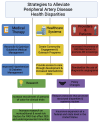Racial and Socioeconomic Health Disparities in Peripheral Artery Disease
- PMID: 39494562
- PMCID: PMC11935724
- DOI: 10.1161/JAHA.123.031446
Racial and Socioeconomic Health Disparities in Peripheral Artery Disease
Abstract
Peripheral artery disease (PAD) is a progressive atherosclerotic disease that causes lower extremity arterial stenosis or occlusion. Patients with PAD are at increased risk of myocardial infarction, stroke, limitations in ambulation, and amputation. Despite the advances in medicine and technology, the outcomes from PAD, including critical limb-threatening ischemia, acute limb ischemia amputation, and mortality, remain increased among specific racial and ethnic groups that have been historically marginalized in America, including Black, Hispanic, and American Indian individuals in the United States when compared with White persons. The purpose of this review is to summarize PAD literature that incorporates racial and ethnic disparities in PAD. There are a rising number of studies focused on the interface of racial and ethnic disparities and PAD. The majority of these studies are specifically focused on Black race, whereas there are limited studies focused on other minoritized racial and ethnic groups in the United States. The application of race and ethnicity has also been shown to play a synergistic role with socioeconomic status on PAD outcomes. Effective strategies focused on implementing policies that support quality measures and focus on social determinants of health have been shown to promote health equity and reduce disparities. Current evidence suggests that biological differences are less likely to be the leading cause of disparities in PAD between racial and ethnic groups compared with White Americans and supports a renewed focus on social determinants of health to achieve health equity.
Keywords: health disparities; patient‐centered; peripheral artery disease (PAD); quality improvement; racial disparities; social determinants of health; socioeconomic disparities.
Figures


Similar articles
-
Regional variation in racial disparities among patients with peripheral artery disease.J Vasc Surg. 2018 Aug;68(2):519-526. doi: 10.1016/j.jvs.2017.10.090. Epub 2018 Feb 16. J Vasc Surg. 2018. PMID: 29459014 Free PMC article.
-
Racial disparities in outcomes of endovascular procedures for peripheral arterial disease: an evaluation of California hospitals, 2005-2009.Ann Vasc Surg. 2015 Jul;29(5):950-9. doi: 10.1016/j.avsg.2015.01.006. Epub 2015 Mar 7. Ann Vasc Surg. 2015. PMID: 25757991 Free PMC article.
-
Disparities in Respiratory Syncytial Virus Risk Factors, Diagnosis, and Outcomes in Adults by Race, Ethnicity, and Other Social Determinants of Health in the United States.Expert Rev Pharmacoecon Outcomes Res. 2025 Apr;25(4):459-471. doi: 10.1080/14737167.2024.2441867. Epub 2024 Dec 24. Expert Rev Pharmacoecon Outcomes Res. 2025. PMID: 39690951 Review.
-
Racial and ethnic disparities in major adverse limb events persist for chronic limb threatening ischemia despite presenting limb threat severity after peripheral vascular intervention.J Vasc Surg. 2023 Mar;77(3):848-857.e2. doi: 10.1016/j.jvs.2022.10.043. Epub 2022 Nov 2. J Vasc Surg. 2023. PMID: 36334848
-
Rural hospital and obstetric unit closures as social determinants of racial and ethnic maternal health disparities: A scoping review.J Adv Nurs. 2024 Aug;80(8):3059-3071. doi: 10.1111/jan.16005. Epub 2023 Dec 2. J Adv Nurs. 2024. PMID: 38041583
Cited by
-
Closer look at the cardiovascular and metabolic predictors of postpartum depression.World J Psychiatry. 2025 Jun 19;15(6):106283. doi: 10.5498/wjp.v15.i6.106283. eCollection 2025 Jun 19. World J Psychiatry. 2025. PMID: 40574759 Free PMC article.
-
Homocysteine Metabolites, Endothelial Dysfunction, and Cardiovascular Disease.Int J Mol Sci. 2025 Jan 16;26(2):746. doi: 10.3390/ijms26020746. Int J Mol Sci. 2025. PMID: 39859460 Free PMC article. Review.
References
-
- Perlstein TS, Pande RL, Beckman JA, Creager MA. Serum total bilirubin level and prevalent lower‐extremity peripheral arterial disease: National Health and nutrition examination survey (NHANES) 1999 to 2004. Arterioscler Thromb Vasc Biol. 2008;28:166–172. doi: 10.1161/atvbaha.107.153262 - DOI - PubMed
-
- McDermott MM, Applegate WB, Bonds DE, Buford TW, Church T, Espeland MA, Gill TM, Guralnik JM, Haskell W, Lovato LC, et al. Ankle brachial index values, leg symptoms, and functional performance among community‐dwelling older men and women in the lifestyle interventions and independence for elders study. J Am Heart Assoc. 2013;2:e000257. doi: 10.1161/jaha.113.000257 - DOI - PMC - PubMed
Publication types
MeSH terms
LinkOut - more resources
Full Text Sources
Medical

